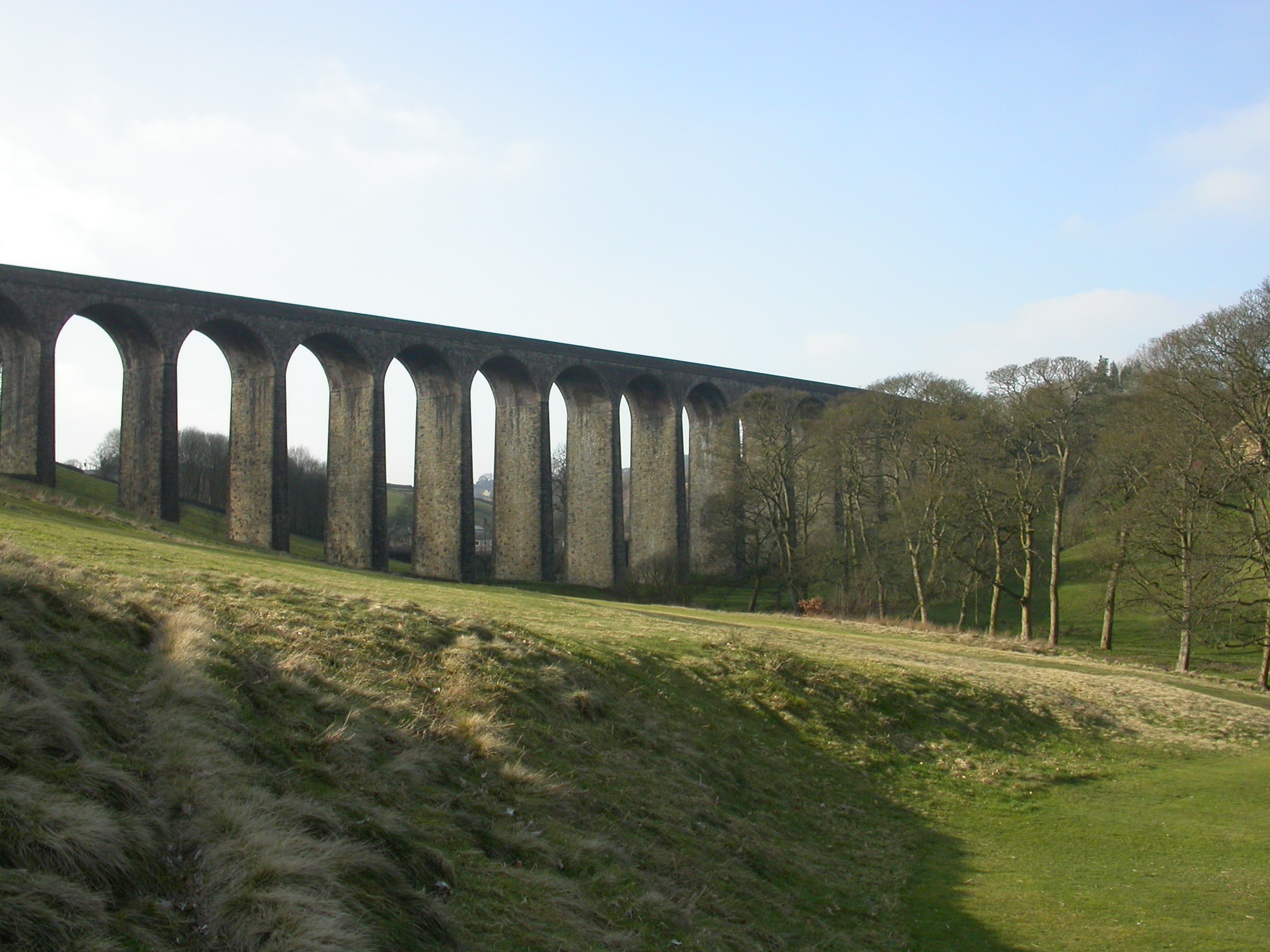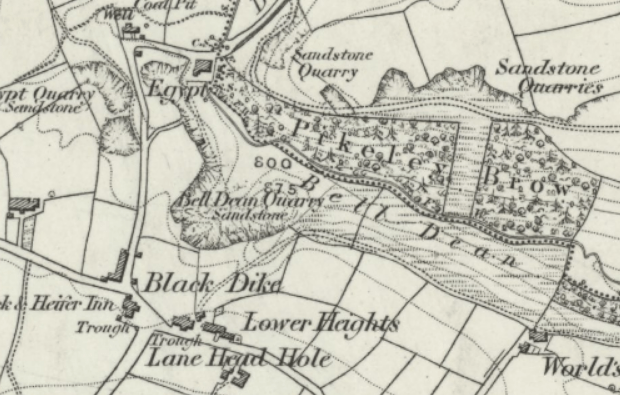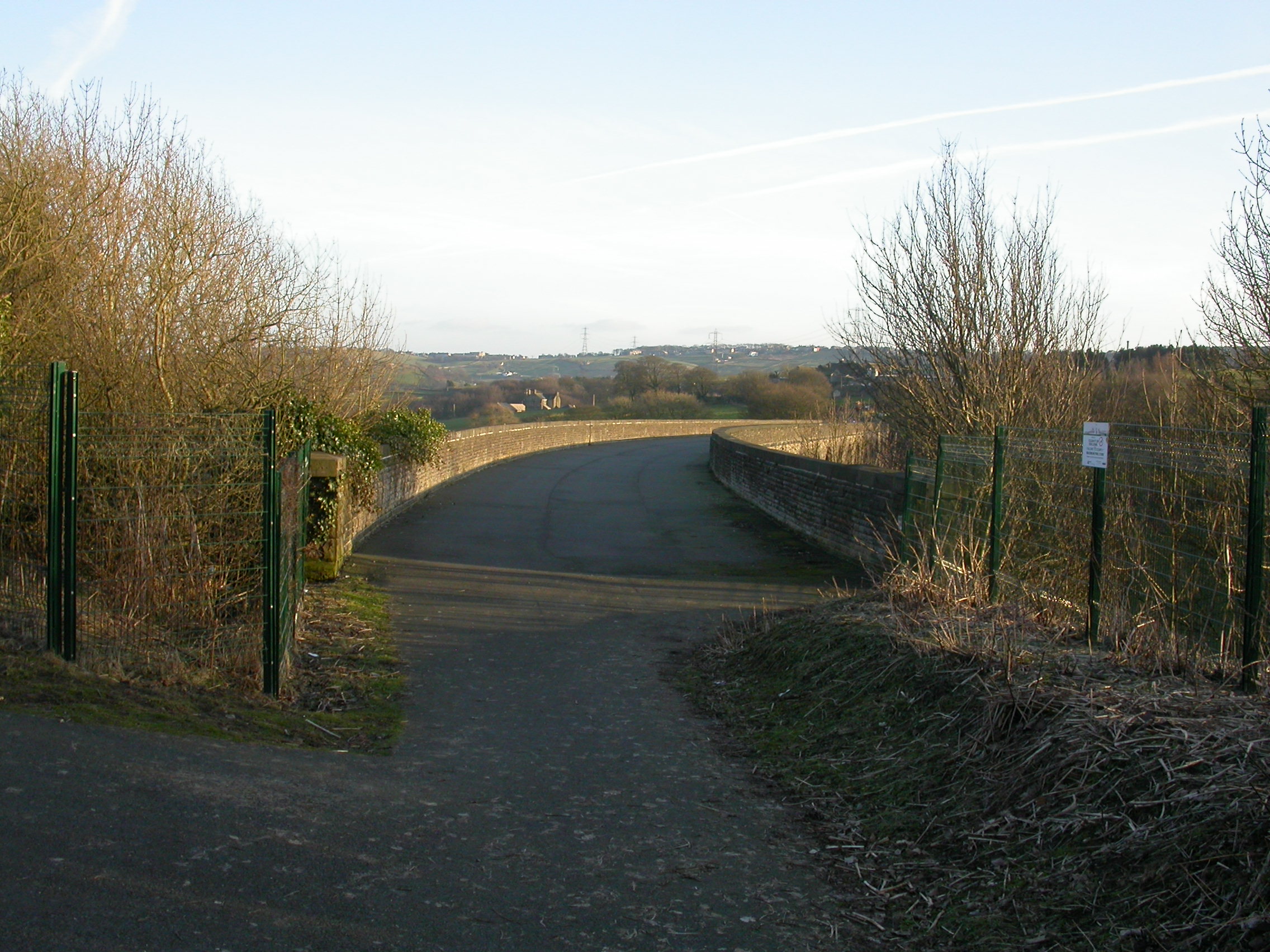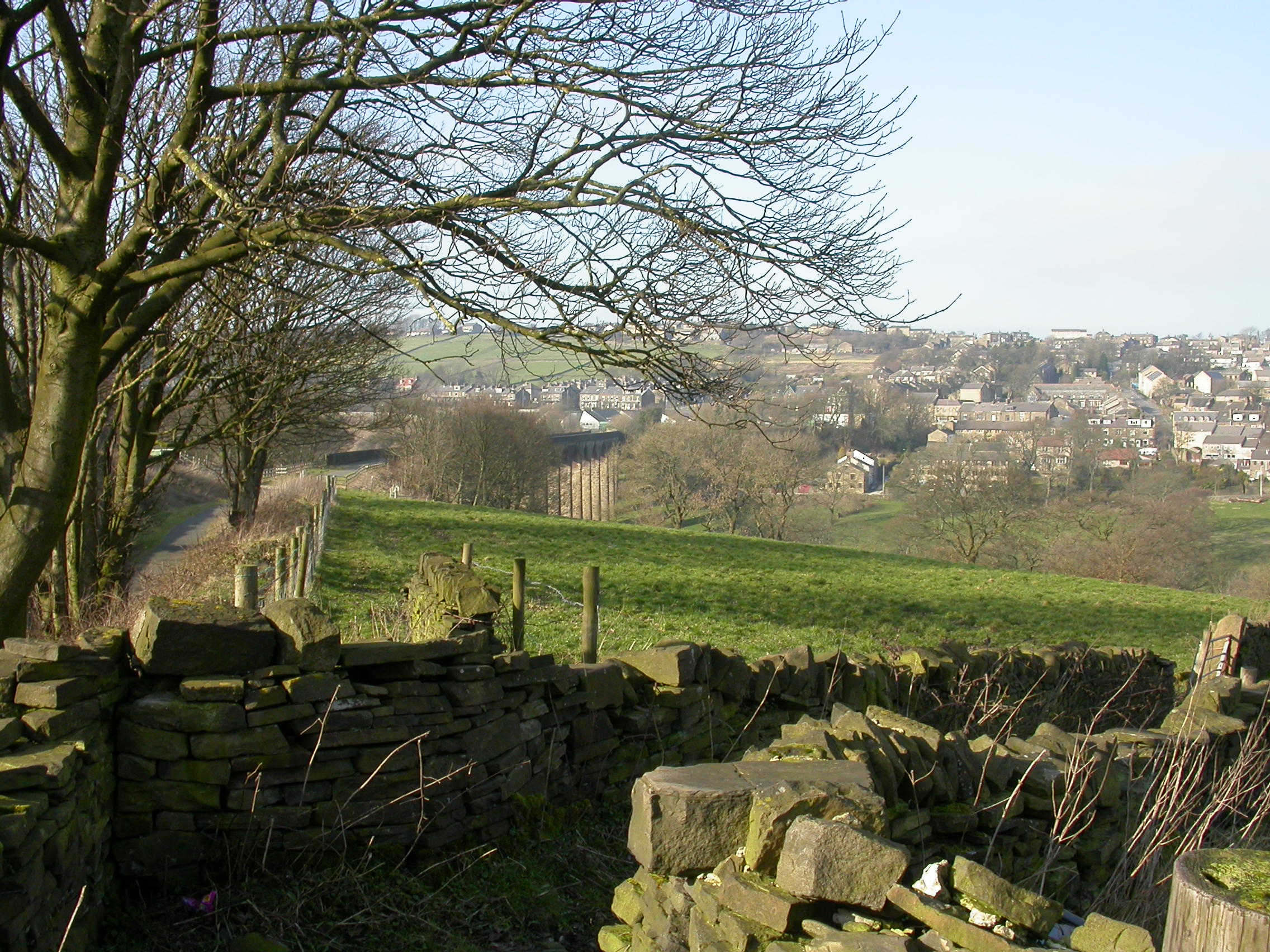

The Thornton branch of the Bradford, Halifax and Keighley Railway was commenced on 11 March 1874 and opened as far as Thornton in 1878. The York Herald of Monday 13 July 1874 reported that the corner-stone of the viaduct had been laid by Mr. Robinson Bentham, and addresses were made by several gentlemen. There was a procession through the streets of Thornton headed by a band of music. The viaduct was built between 1874-76 with locally quarried stone, by Benton and Woodiwiss, subcontracted to Messrs Sykes and Ashcroft, under the supervision of John Rowlands. Rowlands Close in the new housing opposite Thornton Cemetery is named after John Rowlands. John Rowlands, from Tenby in north Wales, settled in Thornton,and is buried in the Bell Chapel churchyard.
The Bradford Observer of 13 July 1974 reports on the proceedings of the laying of a foundation stone, by a workman, Mr. R. Bentham, :
THE BRADFORD AND THORNTON RAILWAY: “The people of Thornton seem determined to mark their appreciation of the blessings of railway communication with the rest of the world. The above new line of railway, which is to effect this desideratum, and which it is gratifying to state is making most satisfactory progress under the energetic management of Messrs. Benton and Woodiwiss, the contractors, seem destined to receive fresh recognition at each stage of its progress. Several “sods” have been cut, and on Saturday last the cornerstone of one of the piers forming the large viaduct across the Pinchbeck valley at Thornton was laid, under the auspices of a committee of working men. This viaduct is a rather important undertaking, stretching as it does across the valley in an oblique direction behind the Old Mill. The opposite sides of this ravine it is intended to connect by a massive stone bridge of twenty arches, each forty feet span, with brick interiors, the average depth being seventy-five feet, and the greatest depth 104 feet. The work has been entrusted by the chief contractors to Messrs. Sykes and Ashcroft, who have already made some progress with the huge job.
Considerable preparation had been made on the part of the committee to render the stone-laying a success, and in inviting the public to join in the procession to the ground assured them that it was to be conducted “in a thoroughly respectable, orderly, and creditable manner”. The procession was formed opposite the Bull’s Head Inn, and consisted of the committee, about thirty in number, each wearing a white rosette, preceded by a youth, the son of Mr. Barker of the Wellington Inn, mounted on a massive draught horse, and gorgeously attired in a blue velvet coat with silver bars and ermine trimmings, carrying the silver trowel. Next followed the Thornton Brass Band in uniform. After, or rather surrounding the committee, came a miscellaneous assemblage of individuals interested in the ceremony. The route of the procession was Market Street, New Road, and Kipping Lane. Arrived at the site, around which and on the overhanging ground a large number of persons had taken up positions, the band played “Auld Lang Syne.”
Mr. J. Shackleton, postmaster, then mounted the stone to present to Mr. R. Bentham, a working man, the silver trowel and a mallet, each with appropriate inscriptions. Both were very handsome implements, the mallet being especially creditable as a specimen of local workmanship. It was composed of boxwood, ebony, ivory and tulip wood, and had been made and presented by Mr. H. Ingham, wood turner, of Market Street, Thornton. Mr. Shackleton, in addressing Mr. Bentham, said that on behalf of the working men of Thornton he had pleasure in presenting to him, as one of their own class, that handsome trowel and mallet. As that was purely a working man’s movement he thought that Mr. Bentham, who had taken such an interest on the progress of the new line, had very appropriately been chosen to perform the ceremony of that day. Speaking of the facilities of travelling to and from Thornton, he said that they had to thank the milkmen for first instituting any means of conveyance whatever. As that trade had developed they had increased facilities for getting backward and forward, and latterly each inhabitant had even the chance of a carriage and pair to Bradford for fourpence. He then referred to the circumstances under which the new line had been brought to the village, and paid a compliment to Mr. Theo. Peel for his exertions in the matter. Mr. Shackleton concluded by making the presentation amid loud cheers. Mr. Bentham then proceeded to lay the stone, the band playing “Rule Britannia”, and afterwards mounted upon it and addressed the assemblage. The speaker’s homely phrase and evident earnestness seemed to amuse the audience greatly, and during his remarks he was loudly cheered, three cheers being given at the close. A volunteer glee party next sang in good style “Comrades in Arms”, and after short addresses from Mr. T. Bates (on behalf of Mr. Midgley Priestley), Mr. W. Williams, and music by the band the proceedings terminated. A collection was made for the Bradford hospitals.”
During its construction at least two men died. The Bradford Observer of 5th September 1874 reported: “FATAL ACCIDENT ON THE BRADFORD AND THORNTON RAILWAY, – An inquest was held at the Bull’s Head Inn, Thornton, on Thursday, on the body of a man named William Henry George Ashcroft, twenty-six years of age, a contractor on the viaduct on the Bradford and Thornton Railway now being constructed at Thornton. In the 1st of September, while he was engaged in guiding a stone about a ton and a half in weight that was being raised by a crane, the guide-strap broke and the crane fell, striking the deceased’s head with the jib-end and killing him on the spot. A verdict of ‘Accidental death’ was returned. Great regret is expressed in Thornton at the sad accident, the deceased being a young man of industry and promise.”
The Bradford Observer of 13 November 1874 reported: “ANOTHER FATAL ACCIDENT ON THE THORNTON RAILWAY, – Yesterday, about noon, another man lost his life while at work on this line, in a singular but at present appears purely accidental manner. Crossing the Pinchbeck Valley approaching the site of the intended station at Thornton, an immense viaduct is being erected beneath which coal had been got some years back. The coal seams are very thin in this part of the valley, but in order to ascertain whether the old workings had sufficiently closed to allow the great weight now being put upon them, an inspection of the foundation was determined upon. For this purpose an old shaft near at hand was made use of, and at the depth of about forty yards, a heading was driven in the direction of the workings, the men engaged being two or three miners being experienced in the work. As the work proceeded, the heading was timbered to support the sides and roof. It was while engaged in this manner yesterday that the fatal accident occurred. A man named John Taylor was engaged at the extremity of the heading, the other being slightly in the rear, when the side of the heading collapsed bring down the timber and the soil on the deceased and another miner, and completely transfixing Taylor. The other man, however, managed to extricate himself, and was only slightly injured. At first the head of Taylor was free from the superincumbant mass, and he was able to call out to his fellows, but before he was got out another fall had taken place, which must have smothered him, and when found there was not a bruise upon him. The body was removed to the Wellington Hotel to await an inquest. Deceased lived at Clayton Heights, but he was a native of Lancashire. He has left a wife and four children. The previous day a rather serious accident happened on the same line at Birks Cutting, by which a navvy had his jaw broken and his head otherwise injured by the jamming of a tip waggon. He was removed to the Bradford Infirmary.”
The next mention of the Viaduct in local newspapers was on 30th November 1876, reported on the “Laying the keystone of the Thornton Viaduct” . Extracts from the over-long article include:
“Yesterday (Wednesday 29 November 1876), the ceremony of laying the keystone of the immense viaduct at Thornton in connection with the Bradford and Thornton Railway was performed by Mr. Isaac Wood, of Headley, in the presence of a large assembly of the inhabitants.“
“The first arch was keyed on May 2, 1874, and the last, as stated above, was yesterday. The viaduct is 280 yards in length, and is of an S curve, the curvatures being at the two extremities of the viaduct. It is composed of twenty arches, each of 40ft. span, the greatest depth being 108ft. to the bottom of the Pinchbeck stream, about 17,000 cubic yards of masonry, and three-quarters of a million bricks being used. The stone has been supplied from Messrs. Farrar’s quarries at Bell Dean, and the bricks by Messrs. Thwaite, of Thornton. More extensive viaducts have been constructed in connection with railway projects throughout the kingdom, but whether from an engineering or an ordinary observer’s point of view, few there are which present such a lightness of appearance combined with substantiality of construction as the one under notice.“
Mr Farrar’s quarry at Bell Dean is shown on the extract from the 1847 6″ to the mile Ordnance Survey map digitised by the National Library of Scotland, reproduced here with their permission for non-commercial purposes.

Mr. Joseph Thwaite’s was based at Ashfield Brick Works in Thornton, but its location is currently unknown

The Bradford Observer continues:
“For several weeks back it has been determined that the keying of the last arch of the viaduct should be celebrated by a public demonstration, although at first only an ordinary workman’s dinner, equivalent to a “rearing supper”, was contemplated. A committee was formed, subscriptions were obtained, and it was determined that Mr. Isaac Wood, of Headley, should be asked, by the process of laying the last stone, to knit the whole structure together. This ceremony was consummated yesterday, and so great was the interest exhibited, that although the mills (which happily now have a full complement of work) were presumably kept running, the great body of the people were sight-seeing.“
“A procession was formed opposite the Great Northern Hotel, and headed by the Thornton Brass Band, marched down Kipping Lane to the eastern end of the viaduct. Here preparations had been made for the laying of the keystone, which was an oblong slab, containing an aperture, wherein was deposited a lead box, the discovery of which, some centuries hence, through the medium of the various papers enclosed within it, may furnish material for the local historian of the period, which he, at least, will daily prize.“
“The committee and others, having ascended to the crown of the arch, Mr. Joseph Shackleton, postmaster, presented to Mr. Isaac Wood a handsome silver trowel, bearing an appropriate inscription, and a mallet gratuitously turned out of foreign woods by Messrs. John Ingham & Sons, of Thornton. In making the presentation, Mr. Shackleton recounted the circumstances which had led to the ceremony in which they were engaged, and hoped that Mr. Wood might be long spared to see the fulfilment of his desire, namely, that prosperity might continue to attend the town of Thornton with the opening prospect before it (Hear, hear).“
“Mr. Wood then proceeded to lay the stone, the band meanwhile playing “Should auld acquaintance be forgot.” This completed, he expressed in homely but evidently heartfelt phrase, the pleasure it had given him to be allowed the opportunity of adding the finishing touch to a work which as a portion of the new railway, would contribute to the future prosperity of his native village. He was sure that the construction of the Thornton railway reflected great praise upon the contractors, who had brought great skill to bear in the carrying out of very difficult works (hear, hear).“
“Mr. Henry Wilson and Mr. E. Shaw, having added a few remarks, a collection was made for the Bradford charities, and the proceedings closed with three hearty cheers and the playing of “God save the Queen by the band. – The procession was then re-formed, and took the direction over the viaduct to the Great Northern Hotel, where a most sumptuous banquet was served up for the subscribers, the committee, the contractors and foremen of the works, and a few invited guests. Altogether about seventy sat down, and complete satisfaction was expressed with the menu provided by Mr. George Wood, the host.“
The article continued with details of the speeches and many toasts at the dinner.
The viaduct became redundant in 1963, but was reopened in 2008 as part of the Great Northern Trail which is part of the Sustrans network of footpaths, bridleways and cycleways.

It is Grade II listed, incorporates 20 barrel vaulted arches – each with a span of 40 feet – and its 300 yard length incorporates a rare S-shaped curve. The S shape was because of the lay of the land and the desired location of the station close to Thornton Road. The old track-bed crosses Pinch Beck at a height of 120 feet. The central piers were sunk 25 feet underground to their foundations. The structure is formed of 17,000 cubic yards of masonry as well as 750,000 bricks. It cost £34,000 to build, at 1878 prices.
For anyone who has a fear of heights, there is a footpath from Lower Kipping Lane to near to where the viaduct footpath, the Great Northern Trail, meets Headley Lane. See the photograph below where the Great Northern Trail comes from the top of the viaduct, by the side of a walled pathway which leads to a footpath across Headley Golf course to the footpath from Lower Kipping Lane.

On 26 November 1989 the viaduct featured in an episode of Last of the Summer Wine, entitled Three Men and a Mangle, (from 18.28 minutes to 22 minutes)
There is a very good video produced by Forgotten Relics Rambles: Thornton to Queensbury, which includes copyrighted photos of Thornton Station, Viaduct and line, as well as details about the building of the railway.
On Youtube there are also several films of the viaduct, the majority filmed from drones. (Search under Thornton Viaduct).
(Updated 31 August 2023 giving details about the laying of the final keystone from the Bradford Observer of 30 November 1876)